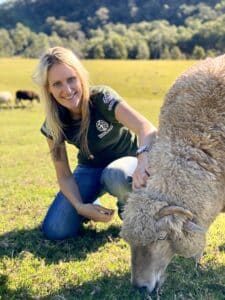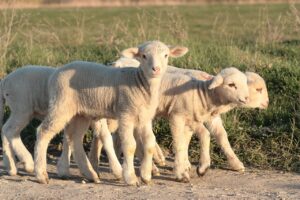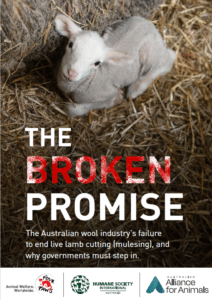One of the most important global meetings on wildlife trade has just wrapped up in Uzbekistan. It’s capital city Samarkand was where governments convened for the 20th Conference of the Parties (CoP20) to the Convention on International Trade in Endangered Species of Wild Fauna and Flora (CITES) to decide how international trade should be managed for some of the world’s most threatened...
Twenty years ago, leaders in the Australian wool industry unanimously promised to phase out live lamb cutting (mulesing) by 2010. But it’s a promise they broke.
As HSI Australia, along with FOUR PAWS and the Australian Alliance for Animals, launch The Broken Promise, a new report into this contentious issue, we sat down with Georgie Dolphin, HSI Australia’s animal welfare campaigner, to find out what live lamb cutting is, and why it needs to end.

HSI: Georgie, what is live lamb cutting, or ‘mulesing’, used for?
Georgie Dolphin: The issue is centred around flystrike. Flystrike is a very serious and painful condition, and it does need to be prevented – we at Humane Society International Australia are not arguing with that. But the common and traditional preventative measure is live lamb cutting, or ‘mulesing’, which is brutally painful and inhumane. So, while flystrike is the problem, the way it is being dealt with—through live lamb cutting—has become a huge animal welfare issue itself, especially because it is unnecessary – there is an effective and humane alternative.
HSI: Let’s start at the beginning: what is flystrike?
GD: Flystrike is caused by the sheep blowfly. They lay their eggs in the warm, moist parts of the sheep like the folds of wrinkled skin around the tail area. Once the blowfly eggs hatch, the maggots eat the surrounding skin causing considerable pain and suffering. Australia’s original Merino sheep were smooth skinned, or ‘plain-bodied’, so they didn’t attract blowflies. But for generations, most Australian wool growers have been deliberately breeding sheep with excessive wrinkled folds of skin designed to maximise the wool yield. It’s these wrinkles that trap moisture from rain and from the sheep’s urine, making them the perfect breeding ground for blowfly larvae.
“…most Australian wool growers have been deliberately breeding sheep with excessive wrinkled folds of skin designed to maximise the wool yield.“
HSI: How did live lamb cutting, or mulesing, begin?
GD: Back in the 1920s, a wool producer named John Mules found that if he cut away the folds of skin from either side of a lamb’s tail using a pair of shears, then the area scarred over as it healed. That area would then be smooth, and wool wouldn’t grow there, so it became resistant to flystrike. That practice became known as mulesing, named after John Mules, but we refer to it today as live lamb cutting.
HSI: Why is live lamb cutting so controversial
GD: Live lamb cutting is an incredibly painful surgical procedure. When a lamb is between two and 12 weeks old, it is restrained in a cradle, and the skin around the tail, and the wool-bearing skin from the tail itself, is literally sliced or cut off. Pain relief is rarely used beforehand, so the lamb feels the full extent of being cut. Most wool growers use a local anaesthetic afterwards, but even when pain relief is used, it is not adequate to eliminate the extensive pain caused by live lamb cutting. Surprisingly, most governments in Australia don’t even require wool growers to use any pain relief at all.

HSI: Why was the name changed from mulesing to live lamb cutting?
GD: Mulesing is a vague term that doesn’t give any indication of what the practice is. Live lamb cutting is much more descriptive. That name change drew a lot of attention and raised a lot of questions. Many people have been quite surprised and upset to find out what actually happens to Australian lambs bred for wool, especially when they learn that an estimated 10 million lambs are subjected to live lamb cutting each year, and that Australia is the only major wool-producing country that still allows it.
“…Australia is the only major wool-producing country that still allows it [mulesing].“
HSI: You mentioned there is an alternative to prevent flystrike. What is it?
GD: Just like when sheep were bred with excessive wrinkles for their wool yield—and consequently more prone to flystrike—they can also be bred to be naturally more resistant to it, with smoother skin. Through careful selection, sheep can be, and are, bred with less wrinkles around the hindquarters, or breech area. Many wool growers now do this, and they no longer need to cut their lambs to prevent flystrike. But unfortunately, most of the Australian wool industry is stuck in their ways, and without strong guidance and direction by the industry leaders to phase out live lamb cutting, progress is extremely slow, and the practice continues. That’s why it’s now essential for governments to intervene.
“…consumers are voting with their feet and are actively seeking brands and retailers who source their wool from non-cut sheep.“
HSI: What are consumers and brands saying?
GD: It’s not just animal welfare organisations calling for an end to live lamb cutting. Increasingly more consumers are becoming aware of what live lamb cutting is, and there are growing calls from people who are demanding an end to it. Those consumers are voting with their feet and are actively seeking brands and retailers who source their wool from non-cut sheep. More than 330 brands and retailers now have policies against live lamb cut wool or are phasing it out of their supply chains – and that number is growing all the time. Some are turning their backs on Australian wool completely, sourcing it from other countries to guarantee it wasn’t from live cut lambs, and some are even opting to avoid wool altogether.
HSI: What is The Broken Promise report?
GD: Twenty years ago, in 2004, leaders from the Australian wool industry promised to phase out live lamb cutting by 2010. But they broke that promise. Everyone has been waiting to see what the industry intends to do but there has been no action, and millions of lambs continue to suffer unnecessarily. In fact, since the 2010 deadline, an estimated 140 million lambs have suffered from this painful procedure. And it is extremely frustrating when we know that a humane alternative has existed for decades.
Humane Society International Australia, along with FOUR PAWS and the Australian Alliance for Animals, has released The Broken Promise report to bring to light the failures of Australia’s wool industry leaders on this issue. The report shows why we must end live lamb cutting and why we are calling on governments to step in to bring an end to this controversial farming practice.
“…since the 2010 deadline, an estimated 140 million lambs have suffered from this painful procedure.“
HSI: Is there anything else you’d like to add?
GD: The fact that Australia is now the only major wool-producing country that still allows live lamb cutting, shows just how far behind we are compared to the rest of the world. It’s tarnishing the whole of the Australian wool industry.
Leaders of Australia’s wool industry once promised to end live lamb cutting; they failed, and they clearly have no intention to end live lamb cutting anytime soon. Consumers want that change, wool growers want that change, and brands want that change. Their time is up, it’s now time for governments to step in.
You can help! Please take action today to call on Australia’s agriculture ministers to phase out live lamb cutting (mulesing).



